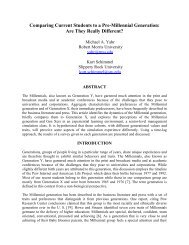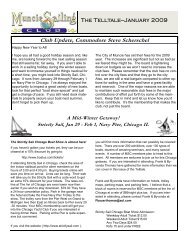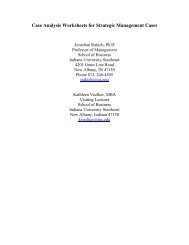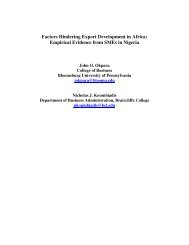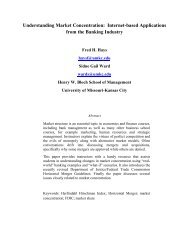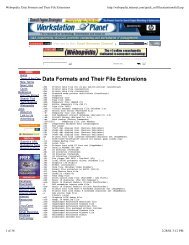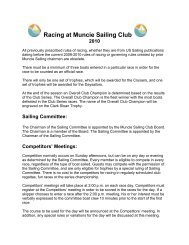Active versus Passive Management of International Mutual Funds ...
Active versus Passive Management of International Mutual Funds ...
Active versus Passive Management of International Mutual Funds ...
Create successful ePaper yourself
Turn your PDF publications into a flip-book with our unique Google optimized e-Paper software.
20<br />
Global Investment Sector. The data contained surviving funds during the period studied. The<br />
categories were matched to the following passive index benchmarks. The Equity Europe<br />
category was first compared to the DAX, a German stock index for 30 selected blue chip stocks.<br />
The equities use free float shares in the index calculation. The second passive index compared to<br />
the Equity Europe category was the FTSE 100, a capitalization-weighted index <strong>of</strong> the 100 most<br />
highly capitalized companies traded on the London Stock Exchange. The third index used in the<br />
comparison was the Dow Jones EURO STOXX 50 Index, a free-float market capitalizationweighted<br />
index <strong>of</strong> 50 European blue-chip stocks from those countries participating in the EMU<br />
[14].<br />
The three indices from the Pacific Region matched to the Equity Asia Pacific active<br />
mutual fund category were the Nikkei-225 Stock Average, a price-weighted average <strong>of</strong> 225 toprated<br />
Japanese companies listed in the first section <strong>of</strong> the Tokyo Stock Exchange. The second<br />
index was the Hang Seng Index, a free-float capitalization-weighted index <strong>of</strong> select companies<br />
from the Hong Kong Stock Exchange. The final Pacific Region index used was the S&P/ASX<br />
200 which measures the performance <strong>of</strong> the 200 largest index-eligible stocks listed on the ASX<br />
by float-adjusted market capitalization [14].<br />
Table 1 depicts the paired index relationships referenced above. The active index on the<br />
left-hand side <strong>of</strong> the table maps to the passive index on the right-hand side <strong>of</strong> the table.<br />
Table 1. Paired Index Relationships<br />
<strong>Active</strong> Index Benchmark Index<br />
1. Equity Europe Dow Jones EURO STOXX 50 Index<br />
2. Equity Europe FTSE 100<br />
3. Equity Europe DAX<br />
4. Equity Asia Pacific Nikkei 225<br />
5. Equity Asia Pacific Hang Seng<br />
6. Equity Asia Pacific S&P/ASX<br />
Data collection methods<br />
Secondary data will be collected and analyzed from the Morningstar Direct database.<br />
Daily data points will be extracted and used for each set <strong>of</strong> paired index comparisons. The daily<br />
data points <strong>of</strong> paired indices were exported into the Micros<strong>of</strong>t Excel computer program<br />
spreadsheet. The means, variances, and related risk-adjusted measures <strong>of</strong> each <strong>of</strong> the paired<br />
indices were calculated, compared, and analyzed.<br />
Research model and variables<br />
Figure 1 shown in Appendix A presents the research model identified in Miller [64]. It<br />
details the relationships among the variables and presents a general flow <strong>of</strong> the study’s logic and<br />
potential outcomes. The independent variable was management style, passive <strong>versus</strong> active while<br />
investment performance was the dependent variable.<br />
Risk-adjusted returns were measured using the Sharpe composite performance measure, a<br />
measure combining risk and return into a single value. The Sharpe ratio was used to compare the<br />
passive and active fund performance [64]. The Sharpe ratio, also known as the reward-tovariability<br />
ratio, was derived from the earlier work <strong>of</strong> Markowitz’s mean-variance model. The<br />
Sharpe measure <strong>of</strong> portfolio performance, S, is stated as:<br />
S = (R i –R FR ) / б i (4)<br />
Where:<br />
R i = the average portfolio return during a specified time period.<br />
R FR = the average return <strong>of</strong> a risk-free investment during the same time.



